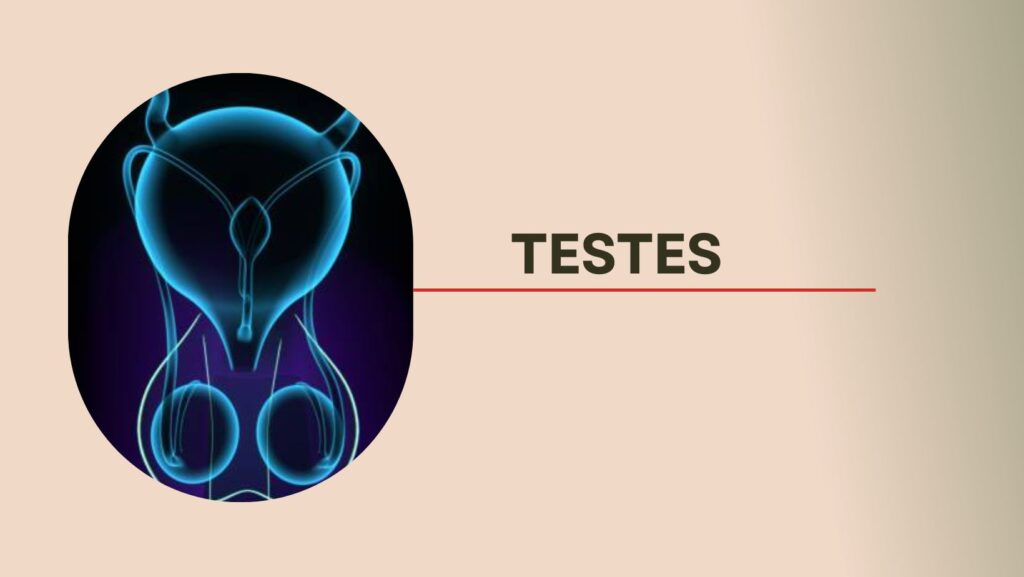Testes
Testes
Descent of testis: The testes develop retroperitoneally in the lumbar region from the genital ridge. During its descent, the testis is preceded by a fold of peritoneum (processus vaginalis) which projects into the foetal scrotum.
We have described in article :
Time of testicular descent
Factor helping the descent of testis :
Undescended testis / Ecotopic testis
Diagnosis and treatment of undescended testes
Complication of an undescended testes

Time of testicular.descent:
- 3rd month of foetal life — iliac fossa.
- 7th month of foetal life deep inguinal ring.
- Later part of 7th month of foetal life — traveling down the inguinal canal.
- 8th month of foetal life-superficial inguinal ring.
- By 9th month i.e. shortly before or at birth-drops into the scrotum, i.e. the final seat of destination.
Factors helping the descent of testis:
- Shortening of and traction of the gubernaculums testis.
- Differential growth of the body wall in relation to relatively immobile gubernaculums.
- Raised intra-abdominal pressure due to foetal accumulation & relative growth of the abdominal viscera pushing the testis through the inguinal canal that is engorged by the swollen gubernaculums.
- Development & maturation of the epididymis inducing testicular descent.
- Hormonal factors- supposed to play the major role in promoting testicular descent. The hormones are hCG from maternal circulation, testosterone & dihydrotestosterone from the testes.
UNDESCENDED TESTES/ECTOPIC TESTES
Undescended testes:
The testes lies in sites other than normal site. When testes cannot be found in scrotum, 3 possibilities should be considered
1) Ectopic testes (common): The testes is abnormally placed outside its normal path such as –
- At the superficial inguinal ring
- In the perineum
- At the root of the penis.
- In the femoral triangle
2) Incompletely descended testes (uncommon); The testes is arrested in some part of its path to thescrotum. The testis may be
- Intra-abdominal.
- Intracanalicular
- Extracanalicular.
- Ectopic.
What is cryptorchidism?
Cryptorchidism: Bilateral undescended testes which are clinically impalpable are called cryptorchidism. In this condition the testes is in the inguinal canal.
Diagnosis & treatment of undescended testes.
Clinical features:
1) It is unilateral on the right side in 50% and on the left in 30%
2) Arrested descent of both testes occurs in 20%
3) Secondary sexual characteristics are normal but other abnormalities of the genitourinary tract may be present.
4) The testis may be
- Intra-abdominal, lying extraperitoneally, usually just above the internal inguinal ring.
- In the inguinal canal, where it may or may not be palpable (When both testes are impalpable in the scrota, the condition is known as cryptorchidism (Hidden testes).
- In the superficial inguinal pouch.
Treatment of undescended testes:
Orchidopexy (orchiopexy) : performed within 2-7 years of age :
- Mobilization of the testis and spermatic cord.
- Retaining the testis in the scrotal septum (Ombredanne’s operation).
> In failure to bring the testis down:
The testis is mobilized as far as possible and anchored with a suture
The mobilization is completed 6 months later.
Orchidectomy :
should be considered if the other testis is normal, especially if the incompletely descended testis is hopelessly atrophic or the patient is past puberty.
> Hormone treatment with HCG (human chorionic gonadotrophin) is only appropriate when there is established hypogonadism.
Hazards/complications of an undescended (incomplete descent) testis:
- Infertility.
- Malignancy: Seminoma.
- Hernia: An associated indirect inguinal hernia is often present.
- Testicular torsion.
- Epididyme-orchitis
Differential diagnoses of groin pain:
This is a very difficult areas to assess as referred pain to the groin cam come from many sources. These include :
- Ureteric colic.
- The hip (labral tears, and osteoarthritis)
- Adductor tendon injuries.
- Stress fractures of the femur, pubis or stress fractures of the femoral neck.
- Hernias (these may be small and include femoral and obturator hernias).
- Tumours
- Sexually transmitted diseases.
- Gynaecological and urinary problems.
- Referred pain from the lumbar spine.

I’m not sure exactly why but this site is loading extremely slow for me. Is anyone else having this problem or is it a issue on my end? I’ll check back later on and see if the problem still exists.
There are certainly a number of details like that to take into consideration. That could be a nice point to bring up. I supply the thoughts above as general inspiration but clearly there are questions just like the one you bring up where an important thing will be working in trustworthy good faith. I don?t know if best practices have emerged round issues like that, however I am positive that your job is clearly identified as a good game. Each boys and girls really feel the impact of only a second’s pleasure, for the remainder of their lives.
This internet site is my intake, real excellent style and design and perfect subject matter.